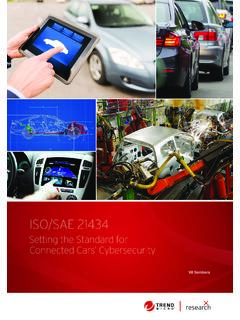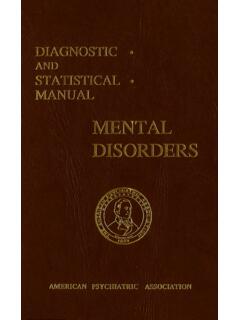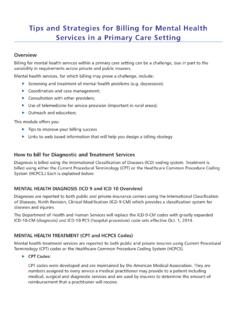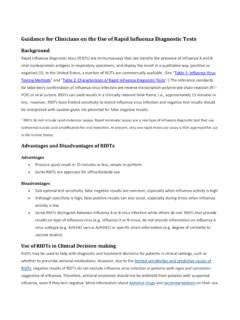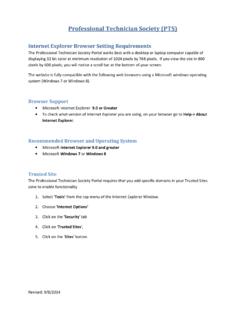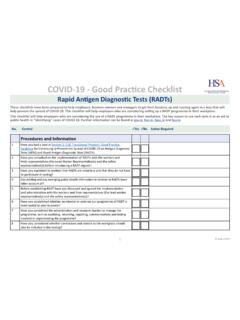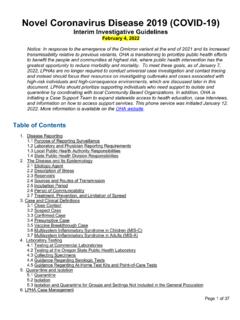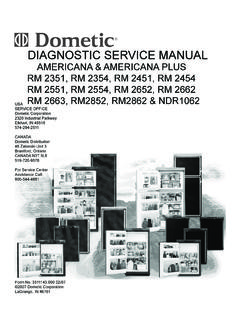Transcription of Setting Up a PCR Laboratory - BioSupplyNet
1 Setting Up a PCR LaboratoryTheodore E. MifflinDepartment of Pathology, University of Virginia, Charlottesville, Virginia 22908 Development of the polymerase chain reaction (PCR) as a basic component of themolecular biology Laboratory has occurred very rapidly from its inception in 1985. Sincethen, more than 15,500 articles have been published in which this technique was used.(See Table 1 for additional information sources for PCR.) As PCR became more widelyused, scientists rapidly learned more about it and, as a result, learned that the PCR had itsstrong points and its deficiencies.
2 Very quickly, PCR demonstrated its power to amplify verysmall amounts ( , a single copy) of template nucleic acid and to amplify different nucle-ic acids ( , DNA and RNA). At the same time, Laboratory personnel learned that thisbiochemical reaction had a unique deficiency; namely, a strong susceptibility to contami-nation from its own product. Early experience with the PCR soon showed that additionalprecautions were needed (Lo et al. 1988; Kwok and Higuchi 1989). This chapter is devot-ed to establishing a PCR Laboratory whose operations will give reliable and contamination-free ISSUESPCR contamination remains an issue for laboratories performing forensic procedures anddetection of infectious agents (Pellett et al.)
3 1999; Scherczinger et al. 1999). There are anumber of approaches to control of PCR contamination, and the degree of stringency thatis required in a Laboratory is often determined by the assay being of Internet Web sites and URLs for PCR information#Web site (URL) Jump station (Web portal) animated video of PCR (PC or MAC) site for checking amplimer (primer) (then select Tech Reports for monograph)PCR contamination to multiplex PCR5 Amplicon AerosolThe single most important source of PCR product contamination is the generation ofaerosols of PCR amplicons that is associated with the post-PCR analysis.
4 Methods for elim-inating this aerosol range from physical design of laboratories and use of specific pipettes tochemical and enzymatic approaches. The choice of method is often dependent on the fre-quency of amplification of a target amplicon and the relative amounts and concentrationsof the amplicons created by the Template ContaminantsIn addition to post-PCR contamination, the target template itself can be a source of con-tamination. For example, DNA templates are typically more troublesome as contaminantsbecause they are more stable than RNA targets. Detection of infectious agents typicallydemands the most stringent contamination efforts, whereas detection of other targets, suchas those from inherited disease, may require less contamination control.
5 Regardless of thetemplate to be detected, good Laboratory practices should be followed (Kwok and Higuchi1989) (see details below). Real-time PCR SystemsPCR systems exist that provide direct measurement of amplicon accumulation during thereaction. These real-time PCR systems offer an alternative approach to the traditional post-PCR analysis methods. From a contamination control perspective, the collection of dataduring the amplification reaction by using a fluorescence-based detection system eliminatesthe need to handle the sample. Thus, when these PCRs are completed, the detection andanalysis are complete, the reaction tubes remain sealed, and there is no amplicon the PCR Laboratory to perform these homogeneous (or real-time) PCRs requiresa different approach, which is addressed later in this chapter.
6 Because the major use of PCRas a Laboratory tool still depends on a separate post-amplification manipulation, thisapproach is the one primarily addressed. CONTAMINATION PREVENTION APPROACHES IN THE PCR LABORATORYThe PCR Laboratory typically is involved with activities that include sample preparation,PCR reaction assembly, PCR execution, and post-PCR analysis. These activities are summa-rized in Figure 1. When arranged in this linear fashion, these activities can be collected intotwo major groups, the pre-PCR activities (sample preparation and PCR preparation) andthe post-PCR activities (PCR execution and analysis).
7 Use of the PCR for research and diagnostic purposes requires that some additional pro-cedural limitations be observed so that the reaction yields valid results. As awareness of thePCR s susceptibility to contamination became known, Kwok and Higuchi (1989) presentedsome additional guidelines for researchers using the PCR. Consistently observing theseguidelines is essential for successfully operating a PCR Laboratory on a long-term form part of a network of protocols focused on maintaining a PCR Laboratory in a con-tamination-free condition. Contamination can arise from several different sources, such as previous amplificationand purification of plasmid clones, repeated isolation of template (genomic) nucleic acids,and previously amplified molecules ( amplicons ).
8 Although most attention in a PCR lab-6 CHAPTER 1 Laboratory SETUP 7oratory is focused on the last category of contamination, the other two sources should notbe ignored. A prudent approach to controlling their contamination is to segregate the morestandard recombinant DNA activities into separate areas of the Laboratory and, in particu-lar, to limit the performance of PCR activities to its own area. For PCR amplicon contamination, it is the control and removal of the PCR ampliconsthat form the basis for the contamination control program. When PCR is used in researchlaboratories, either a greater variety of templates or amplifications of a specific template willbe studied or manipulated and, thus, controlling amplicon contamination may be less chal-lenging.
9 In a diagnostic Laboratory , there can be more opportunities for PCR contaminationdue to the repeated analysis of selected templates and the fact that PCR assays may be per-formed at or near the detection limit of PCR. The last possibility is especially demandingand thus requires a much more rigorous approach to controlling PCR essential parts of this contamination control program include space and time sep-aration of pre- and post-PCR activities, use of physical aids, use of ultraviolet (UV) light,use of aliquoted PCR reagents, incorporation of numerous positive and negative or blankPCRs (H2O substituted for template), and use of one or more various contamination con-trol methods that use chemical and biochemical reactions.
10 The underlying theme in theseactions is the recognition that amplicon contamination cannot be seen, felt, or a prioridetected before it happens. Use of consistent, careful technique coupled with liberal incor-poration and monitoring of PCR blanks will ensure a vigilant, proactive approach to and Time SeparationAs illustrated in Figure 1, the main source of the feedback contamination is the ampliconsgenerated by the previous PCR. By separating the source of the amplicons ( , post-PCR)activities from the pre-PCR activities, the potential for contamination is significantlyreduced. This separation is best illustrated by separating the facilities in space, so that thereare two rooms where these activities occur (Fig.)
